
Questions?
Email us at: JandK@LivingGoldPress.com
 HOME
HOME

 |
Email us at: JandK@LivingGoldPress.com
|
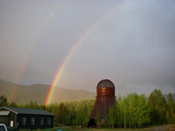 |
 |
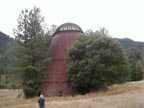 |
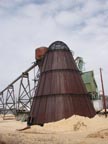 |
 |
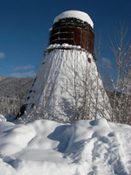 |
| Teepee burners. Once so ubiquitous in the Northwest that the opportunity to photograph one in action passed, as too many photo opps do, before we realized it. What you see now, where they havenít been torn down, are rusted relics, structures of simple, soaring beauty, testaments to a once thriving timber industry. Gone are the days when a warm glow in the distance pierced the drizzly night, embers spewing a welcome as your car passed by the mill site on the highway, windows transmitting a bit of the heat. Gone, for better or worse.
Teepee burners, or wood burners, were used to burn mill waste up until the mid-70s. And what a lot of waste there was. Even by 1970 it is estimated that only about 50% of every tree cut was utilized. Even less was used in the early days when refuse was often sent down a river or burned in open pits. Mills were tinderboxes just waiting to ignite (and many did)and the flammable sawdust needed to be disposed of. Wood burners were a vast improvement in efficiency and safety (i.e. CONTAIN the fire). Early cylindrical models came out of Michigan before 1900. They were lined with fire brick and they were expensive. A Northwest firm, Colby Engineering of Portland, pioneered the economical cone-shaped design in 1916. With itís flared base that kept the flames away from cone, they were built of two steel shells with air in between, no brick necessary. It was topped with a screened cap. A new icon was born. Patents on variations of the cone proliferated from other manufacturers or sometimes burners were fabricated on the site. The variety of building techniques, materials available and type of waste to be disposed of made each burner almost unique, although the basic form remained the same. All successful designs followed two rules of thumb. The first was that the diameter of the base equaled the distance between the base and the bottom of the cap. Secondly, the diameter of the cap was half that of the base. Environmental laws regarding air pollution (the Clean Air Act of 1970) put the teepee burners to rest by about 1980. Besides the resulting cleaner air, as much ďwasteĒ material as possible began to be diverted into manufacturing wood products other than lumber. Some mills converted the burners into chip or sawdust hoppers. But alas, the industry is dwindling and countless mills have shut down. Itís fun to keep your eyes open for the rusty burners as you cruise the highways and backroads of northern California and the Northwest. They often stand alone in an opening that was once a bustling lumber mill. To a LIST of remaining burners. |
NOTES: Rainbow and snow photos courtesy of Marion Foley from Abbott Valley, Montana near Martin City, eight miles from West Glacier. Thank you!Postcard of Pickering Lumber Mill, Alturas, CA (undated) is from the Eastman Collection, UC Davis.
Some of the information in this piece came from Wood Burners |
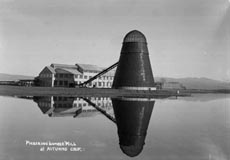 |
HOME Hot Topics INDEX |